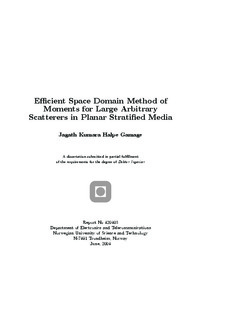| dc.description.abstract | Keywords : Conjugate gradient fast Fourier transform (CG-FFT), Discrete complex image method (DCIM), Electric field integral equation (EFIE), Frequency selective surfaces (FSS), Generalized pencil-of-functions (GPOF), Green’s function (GF), Method of moments (MoM), Prony’s method (PM), Sommerfeld integral (SI), Two-dimensional generalized exponential integral (2D-GEI)
As the need for more frequency spectrum drives the design of antennas and other microwave components at higher frequencies, compact but electrically large microwave components are beginning to appear. Since a significant share of these components comprises scatterers etched on planar stratified layers, efficient tools analyzing and optimizing such structures are invaluable. The work carried out here is in fact a continuation of the research performed in the past at the Department of Electronics and Telecommunications at the Norwegian University of Science and Technology in Trondheim, Norway.
The conventional method of moments for analyzing and optimizing scatterers in stratified media is simple in formulation but computationally very intensive. Moreover, the computer memory usage of the software based on conventional MoM is high. Both these factors have so far limited the application of conventional MoM to electrically small and simpler stratified structures. Therefore, the present work focuses on introducing and implementing an improved space domain MoM for large radiating or scattering structures etched on planar stratified media. The space domain method of moments is selected due to its simplicity and potential for further improvements when compared with the spectral domain method of moments.
The major areas of space domain MoM such as finding spectral Green's functions, deriving spatial Green’s functions, matrix formulation and matrix inversion are addressed.
The existing methods are evaluated with respect to their pros and cons. In addition, in order to extract the scattering parameters a few simple de-embedding techniques are introduced. We have attempted to optimize each stage of the conventional space domain MoM such that it can handle electrically large scatterers in planar stratified media. Each method is discussed independently and proved to be performing well compared with the corresponding method applied in conventional space domain MoM. In deriving spectral Green’s functions, a novel formulation of transmission line theory is applied easing the analytical derivation and the software implementation significantly. A robust form of discrete complex image method (DCIM) is used in deriving spatial Green’s functions from the corresponding spectral Green’s functions. DCIM is an accurate and efficient way of evaluating Sommerfeld integrals without resorting to multi-dimensional numerical integration.
The accuracy and efficiency of DCIM are affirmed by applying it to simple scatterers. The outcome of DCIM is a sum of complex exponential functions. These are then used to calculate the impedance matrices of MoM. It is also shown that when using mixed potential integral formulation, the original four-dimensional numerical integration can be simplified to two-dimensional integration with no loss of accuracy, thus reducing the mathematical complexity during matrix filling phase. Nevertheless, some of the complex exponential functions can lead to two-dimensional singular integrals. These singular two- dimensional generalized exponential integrals(2D-GEI) are efficiently handled by generalizing an innovative numerical integration method, thus saving the processing time further. The last but most important operation of MoM, the matrix inversion is achieved by using an iterative algorithm known as conjugate gradient method. It is then combined with fast Fourier transform to exploit the space invariant property present in the impedance matrices of MoM. A new compact formulation of the matrices is also presented to facilitate the programing task. To our knowledge, this is the first time such formulation is presented explicitly. A brief chapter is reserved for de-embedding of scattering parameters from the surface current densities resulting from MoM.
In order to present the thesis as a collection of self-containing and independent chapters, results are included in each chapter whenever it is appropriate. These partial results confirm the accuracy and the efficiency of each method introduced in the corresponding chapter before we move on to the next. The conclusion on the overall method introduced in this work is that the space domain method of moments combined with the discrete complex image method and the conjugate gradient fast Fourier transform presents a very powerful tool for analyzing and optimizing large arbitrary stratified structures. However, to be competitive with commercial products based on either spectral domain method of moments or finite element methods, further improvements in its implementation and methodology are needed. Few improvements such as more efficient implementation of the entire method, inclusion of surface wave contribution in DCIM, integration of non-uniform basis and testing functions and need for better de-embedding techniques are already identified at the end of this work.
Finally we hope that this work clarifies some important issues relating to space domain method of moments when applied to large scatterers etched on planar stratified media and encourages the further research on this particular method. | nb_NO |
